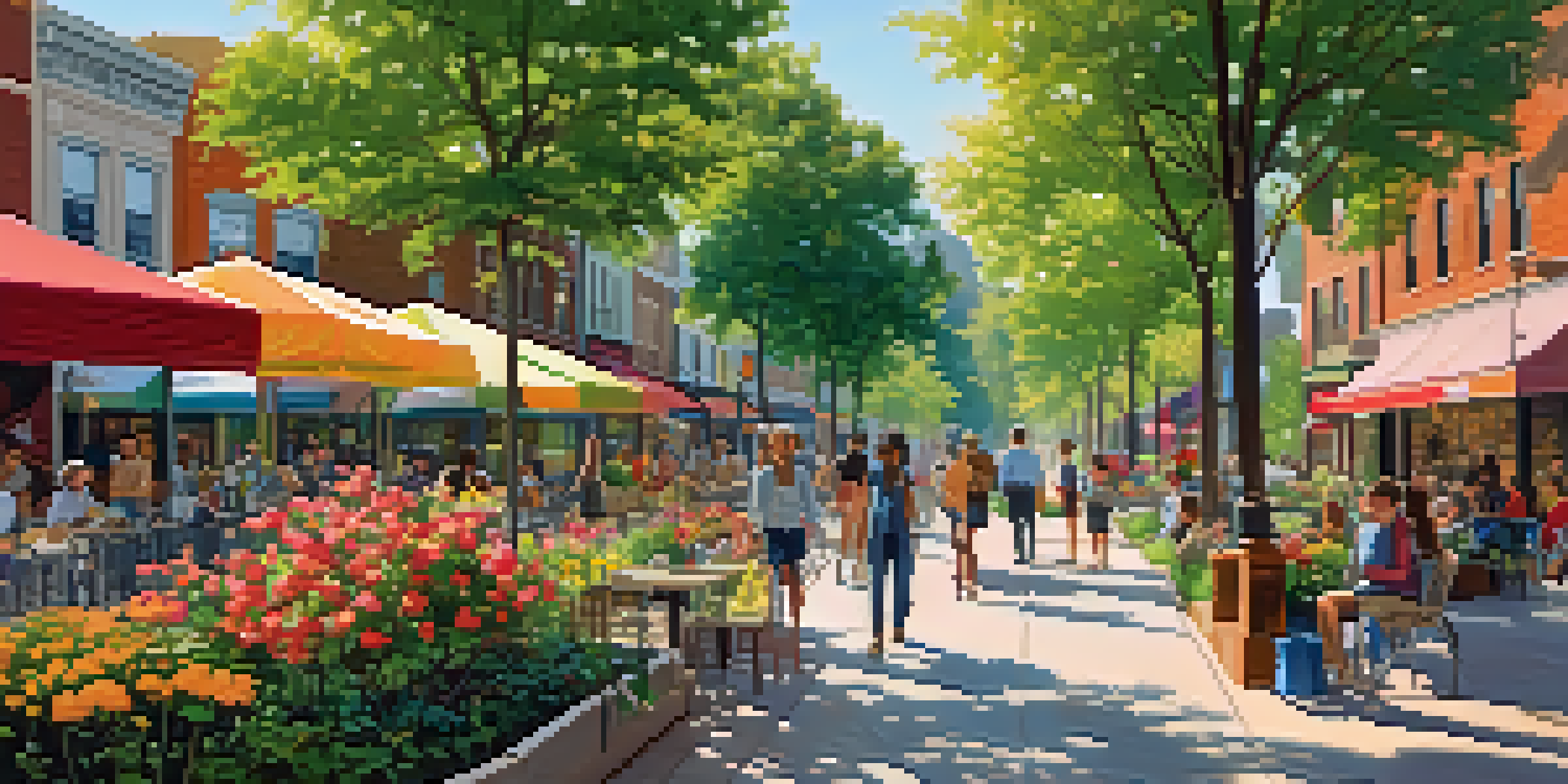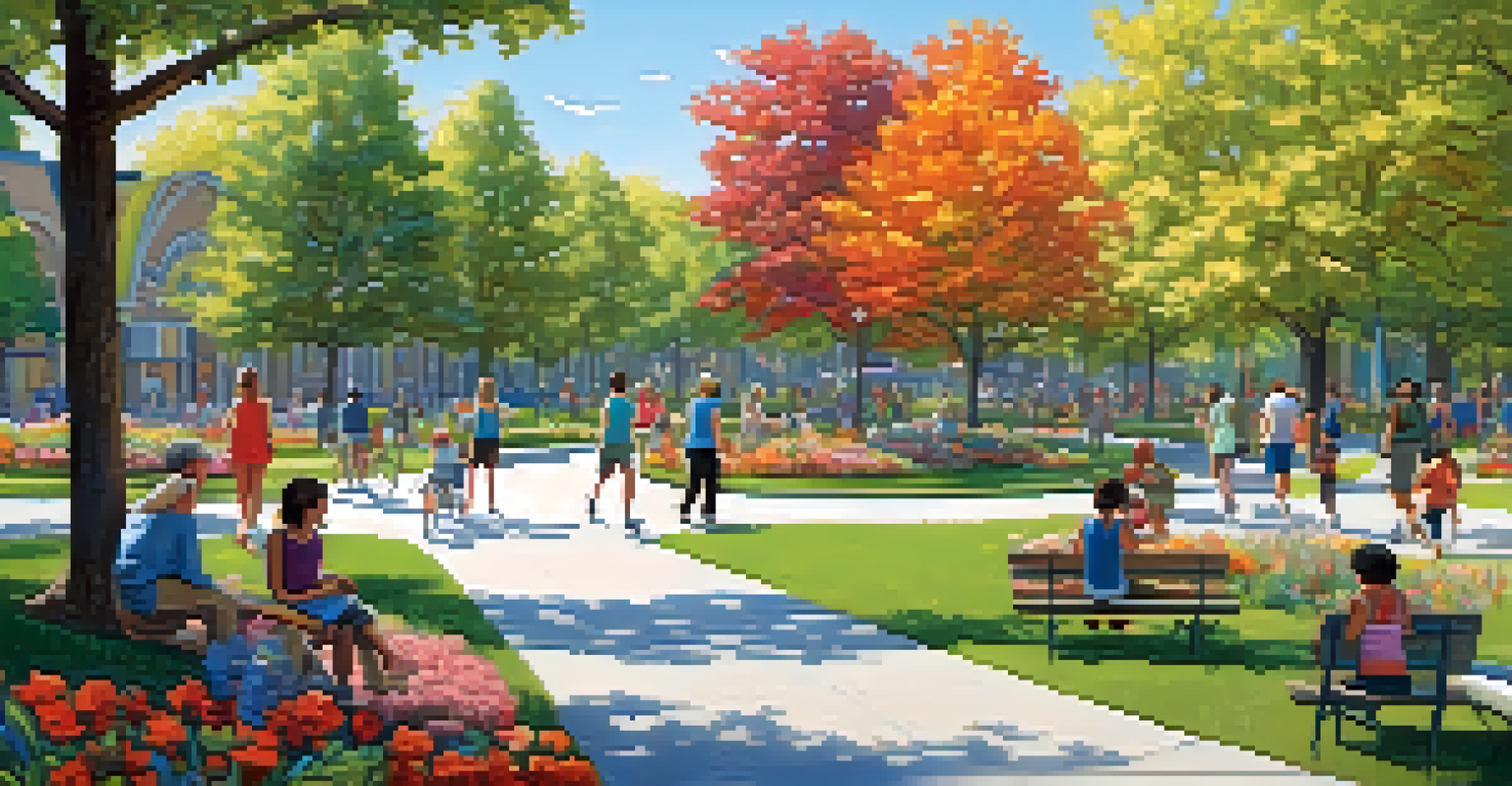The Role of Walkable Communities in Promoting Health

Understanding Walkable Communities and Their Importance
Walkable communities are designed to encourage walking and biking, making it easy for residents to access daily amenities. They typically feature pedestrian-friendly infrastructure, such as sidewalks, crosswalks, and parks. This design not only fosters a sense of community but also promotes a healthier lifestyle.
Walking is the best possible exercise. Habituate yourself to walk very far.
These communities often prioritize mixed-use development, where homes, shops, and services are close together. This proximity makes it convenient for people to walk instead of relying solely on cars. As a result, residents can incorporate physical activity into their daily routines without even thinking about it.
In essence, walkable communities create an environment where walking becomes a natural part of life. This accessibility and convenience can significantly improve overall health and well-being, making it a vital component of urban planning.
The Link Between Walkability and Physical Activity
Research shows that people living in walkable neighborhoods are more likely to engage in regular physical activity. The mere presence of sidewalks, parks, and bike lanes invites residents to step outside and move. This increase in daily movement contributes to better cardiovascular health and lower obesity rates.

Moreover, the social aspect of walkable communities cannot be overlooked. Walking in shared spaces encourages interactions with neighbors, fostering a sense of community. This social engagement is crucial, as studies indicate that social connections can positively influence mental health and motivation to stay active.
When communities prioritize walkability, they effectively create a culture of health. The ease of walking not only benefits individual health but also enhances the collective well-being of the entire neighborhood.
Mental Wellbeing and Walkable Spaces
Walking in nature or well-designed urban areas has been linked to improved mental health. Access to parks and green spaces allows individuals to unwind, reduce stress, and enhance their mood. In walkable communities, these spaces are often just a short stroll away, making them easily accessible.
The greatness of a community is most accurately measured by the compassionate actions of its members.
Additionally, the act of walking itself can have therapeutic effects. It provides time for reflection, mindfulness, and even social interaction, all of which contribute to improved emotional well-being. This is especially important in today's fast-paced world, where mental health issues are on the rise.
In summary, walkable communities play a vital role in supporting mental health by providing accessible spaces for relaxation and social connection. This holistic approach to health emphasizes the importance of both physical and emotional well-being.
Reducing Environmental Impact Through Walkability
Walkable communities not only benefit individual health but also contribute to a healthier planet. When people choose to walk or bike instead of drive, they help reduce traffic congestion and lower greenhouse gas emissions. This shift is crucial in combating climate change and promoting sustainability.
Moreover, walkable neighborhoods often promote the use of public transportation, which further minimizes environmental impact. With accessible transit options, residents are more likely to leave their cars behind, leading to cleaner air and a reduced carbon footprint.
In this way, fostering walkable communities is a win-win situation. They not only enhance personal health but also contribute to a more sustainable future for generations to come.
Economic Benefits of Walkable Communities
Investing in walkable infrastructure can lead to significant economic benefits for communities. Businesses in walkable areas often see increased foot traffic, which translates to higher sales. Customers are more likely to stop in for a coffee or shop when they can easily stroll to their favorite spots.
Furthermore, walkable neighborhoods tend to attract higher property values. Homebuyers are increasingly looking for areas that prioritize walkability, which can lead to a stronger local economy. As demand increases, so does the value of properties, benefiting both homeowners and local governments.
Ultimately, the economic advantages of walkable communities create a thriving environment that supports local businesses and enhances the quality of life for residents.
Designing for Accessibility in Walkable Communities
Creating truly walkable communities goes beyond just adding sidewalks; it requires thoughtful design that considers all residents. Accessibility features, such as curb cuts and tactile paving, ensure that individuals with disabilities can navigate their neighborhoods safely. This inclusivity is essential for fostering a sense of belonging.
Additionally, community input plays a crucial role in the design process. Engaging residents in discussions about their needs and preferences can lead to more effective and embraced solutions. When people feel heard, they are more likely to invest in and take pride in their neighborhoods.
By prioritizing accessibility, communities can ensure that walking is a viable option for everyone, further enhancing health outcomes and community cohesion.
The Future of Walkable Communities and Public Health
As we move forward, the concept of walkable communities will become increasingly vital in public health discussions. Urban planners and policymakers are recognizing the connection between the built environment and health outcomes. This awareness is prompting a shift towards prioritizing walkable designs in city planning.
Innovations in technology, such as smart city solutions, can further enhance walkability. From apps that help navigate pedestrian routes to improved public transit options, technology can make it easier to choose walking over driving. This integration can significantly impact public health and environmental sustainability.

In conclusion, the future of walkable communities is bright, with the potential to create healthier, more vibrant environments for all. By embracing this model, we can pave the way for a healthier public and a more sustainable world.